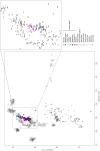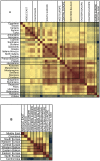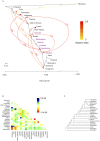Standing at the gateway to Europe--the genetic structure of Western balkan populations based on autosomal and haploid markers - PubMed (original) (raw)
. 2014 Aug 22;9(8):e105090.
doi: 10.1371/journal.pone.0105090. eCollection 2014.
Kristiina Tambets 2, Anne-Mai Ilumäe 2, Alena Kushniarevich 2, Bayazit Yunusbayev 3, Anu Solnik 2, Tamer Bego 4, Dragan Primorac 5, Vedrana Skaro 6, Andreja Leskovac 7, Zlatko Jakovski 8, Katja Drobnic 9, Helle-Viivi Tolk 2, Sandra Kovacevic 10, Pavao Rudan 11, Ene Metspalu 2, Damir Marjanovic 12
Affiliations
- PMID: 25148043
- PMCID: PMC4141785
- DOI: 10.1371/journal.pone.0105090
Standing at the gateway to Europe--the genetic structure of Western balkan populations based on autosomal and haploid markers
Lejla Kovacevic et al. PLoS One. 2014.
Abstract
Contemporary inhabitants of the Balkan Peninsula belong to several ethnic groups of diverse cultural background. In this study, three ethnic groups from Bosnia and Herzegovina - Bosniacs, Bosnian Croats and Bosnian Serbs - as well as the populations of Serbians, Croatians, Macedonians from the former Yugoslav Republic of Macedonia, Montenegrins and Kosovars have been characterized for the genetic variation of 660 000 genome-wide autosomal single nucleotide polymorphisms and for haploid markers. New autosomal data of the 70 individuals together with previously published data of 20 individuals from the populations of the Western Balkan region in a context of 695 samples of global range have been analysed. Comparison of the variation data of autosomal and haploid lineages of the studied Western Balkan populations reveals a concordance of the data in both sets and the genetic uniformity of the studied populations, especially of Western South-Slavic speakers. The genetic variation of Western Balkan populations reveals the continuity between the Middle East and Europe via the Balkan region and supports the scenario that one of the major routes of ancient gene flows and admixture went through the Balkan Peninsula.
Conflict of interest statement
Competing Interests: The authors have the following interests. Dr. Vedrana Skaro's affiliation to Genos company does not alter the authors' adherence to PLOS ONE policies on sharing data and materials.
Figures
Figure 1. Map of the Western Balkan region with triangles corresponding to the regions from where blood samples were collected.
The sample of Bosnia and Herzegovina consisted of subsamples of three main ethnic groups: Bosniacs (Sarajevo and Zavidovici), Bosnian Croats (Central Bosnia - Zepce and Maglaj; South Bosnia and Herzegovina - Mostar, Grude, Livno, Capljina), Bosnian Serbs (Doboj and Banjaluka region); Croatia (mainland, Zagreb region), Serbia (Belgrade region), Montenegro (Podgorica), Kosovo (Pristina and Prizren) and Macedonia (Skopje).
Figure 2. ADMIXTURE analysis of autosomal SNPs of the Western Balkan region in a global context on the resolution level of 7 assumed ancestral populations (See Table S1 for population data).
Figure 3. Principal component (PC) analysis of the variation of autosomal SNPs in Western Balkan populations in Eurasian context (PC1 versus PC2; see Table S1 for population data).
Figure 4
A: FST-distances based on the variation of autosomal SNPs. A: FST-distances of Western Balkans populations in a global context; B: Region-wise FST-distances of the studied populations. FST-values are from 0,03 (dark blue) to 0,00005 (dark brown).
Figure 5. Network of 29 populations constructed with the Neighbor-net approach from FST distances based on the variation of autosomal SNPs.
Western Balkan populations are indicated with violet color.
Figure 6. TreeMix analysis of Western Balkan and surrounding populations (see Table S1 for population data).
TreeMix graph represents the model of 10 gene-flow events within the sample. A. The population tree with gene-flow (migration) events. The scalebar specifies the weight of a migration, precise value of it is shown on the migration edges; B. Residuals plot; C. Ultrametric tree.
Figure 7. Average number of ibd segments per pair shared between Muslim Western Balkan populations (A – Bosniacs; B - Kosovars) and Middle Eastern (Saudis, Iranians, Syrians, Turks, Palestinians) and other non-Muslim Western Balkan populations (Bosnian Croats and Serbs, Croatians, Macedonians, Serbians, Montenegrins).
Similar articles
- Mitochondrial DNA perspective of Serbian genetic diversity.
Davidovic S, Malyarchuk B, Aleksic JM, Derenko M, Topalovic V, Litvinov A, Stevanovic M, Kovacevic-Grujicic N. Davidovic S, et al. Am J Phys Anthropol. 2015 Mar;156(3):449-65. doi: 10.1002/ajpa.22670. Epub 2014 Nov 24. Am J Phys Anthropol. 2015. PMID: 25418795 - Distribution of Y-chromosome haplogroups in Serbian population groups originating from historically and geographically significant distinct parts of the Balkan Peninsula.
Mihajlovic M, Tanasic V, Markovic MK, Kecmanovic M, Keckarevic D. Mihajlovic M, et al. Forensic Sci Int Genet. 2022 Nov;61:102767. doi: 10.1016/j.fsigen.2022.102767. Epub 2022 Aug 17. Forensic Sci Int Genet. 2022. PMID: 36037736 - The peopling of modern Bosnia-Herzegovina: Y-chromosome haplogroups in the three main ethnic groups.
Marjanovic D, Fornarino S, Montagna S, Primorac D, Hadziselimovic R, Vidovic S, Pojskic N, Battaglia V, Achilli A, Drobnic K, Andjelinovic S, Torroni A, Santachiara-Benerecetti AS, Semino O. Marjanovic D, et al. Ann Hum Genet. 2005 Nov;69(Pt 6):757-63. doi: 10.1111/j.1529-8817.2005.00190.x. Ann Hum Genet. 2005. PMID: 16266413 - Pleistocene divergence of Dinaric Drusus endemics (Trichoptera, Limnephilidae) in multiple microrefugia within the Balkan Peninsula.
Previsić A, Walton C, Kucinić M, Mitrikeski PT, Kerovec M. Previsić A, et al. Mol Ecol. 2009 Feb;18(4):634-47. doi: 10.1111/j.1365-294X.2008.04046.x. Epub 2009 Jan 16. Mol Ecol. 2009. PMID: 19175506 - Mitochondrial super-haplogroup U diversity in Serbians.
Davidovic S, Malyarchuk B, Aleksic J, Derenko M, Topalovic V, Litvinov A, Skonieczna K, Rogalla U, Grzybowski T, Stevanovic M, Kovacevic-Grujicic N. Davidovic S, et al. Ann Hum Biol. 2017 Aug;44(5):408-418. doi: 10.1080/03014460.2017.1287954. Epub 2017 Feb 19. Ann Hum Biol. 2017. PMID: 28140657
Cited by
- Genetic Landscapes Reveal How Human Genetic Diversity Aligns with Geography.
Peter BM, Petkova D, Novembre J. Peter BM, et al. Mol Biol Evol. 2020 Apr 1;37(4):943-951. doi: 10.1093/molbev/msz280. Mol Biol Evol. 2020. PMID: 31778174 Free PMC article. - Dissecting dynamics and differences of selective pressures in the evolution of human pigmentation.
Huang X, Wang S, Jin L, He Y. Huang X, et al. Biol Open. 2021 Feb 9;10(2):bio056523. doi: 10.1242/bio.056523. Biol Open. 2021. PMID: 33495209 Free PMC article. - PGG.SNV: understanding the evolutionary and medical implications of human single nucleotide variations in diverse populations.
Zhang C, Gao Y, Ning Z, Lu Y, Zhang X, Liu J, Xie B, Xue Z, Wang X, Yuan K, Ge X, Pan Y, Liu C, Tian L, Wang Y, Lu D, Hoh BP, Xu S. Zhang C, et al. Genome Biol. 2019 Oct 22;20(1):215. doi: 10.1186/s13059-019-1838-5. Genome Biol. 2019. PMID: 31640808 Free PMC article. - Refining the Global Phylogeny of Mitochondrial N1a, X, and HV2 Haplogroups Based on Rare Mitogenomes from Croatian Isolates.
Havaš Auguštin D, Šarac J, Reidla M, Tamm E, Grahovac B, Kapović M, Novokmet N, Rudan P, Missoni S, Marjanović D, Korolija M. Havaš Auguštin D, et al. Genes (Basel). 2023 Aug 12;14(8):1614. doi: 10.3390/genes14081614. Genes (Basel). 2023. PMID: 37628665 Free PMC article. - Integrating Linguistics, Social Structure, and Geography to Model Genetic Diversity within India.
Bose A, Platt DE, Parida L, Drineas P, Paschou P. Bose A, et al. Mol Biol Evol. 2021 May 4;38(5):1809-1819. doi: 10.1093/molbev/msaa321. Mol Biol Evol. 2021. PMID: 33481022 Free PMC article.
References
- Imamovic E, Lovranovic D, Nilevi'CB, Sunjic M, Zlatar B, et al... (1998) Bosnia and Herzegovina – from the oldest age until Second World War. Sarajevo: Bosanski kulturni centar. 13–41 pp.
- Pinhasi R, Foley RA, Lahr MM (2000) Spatial and temporal patterns in the Mesolithic-Neolithic archaeological record of Europe. In: Renfrew C, Boyle K, editors. Archaeogenetics: DNA and the population prehistory of Europe. Cambridge: McDonald Institute for Archaeological Research Monograph Series, Cambridge University. pp.45–56.
- Lahr MM, Foley RA (1998) Towards a theory of modern human origins: Geography, demography, and diversity in recent human evolution. Am J Phys Anthropol Suppl: 137–176. Available: http://www.ncbi.nlm.nih.gov/pubmed/9881525. Accessed 30 November 2012. - PubMed
- Wachtel AB (2008) The Balkans in World History. Oxford: Oxford University Press. 7–10 pp.
- Karavanic I, Smith FH (1998) The Middle/Upper Paleolithic interface and the relationship of Neanderthals and early modern humans in the Hrvatsko Zagorje , Croatia. 34: 223–248. - PubMed
Publication types
MeSH terms
Substances
Grants and funding
This work was supported by the European Union European Regional Development Fund through the Centre of Excellence in Genomics, by the Estonian Biocentre (EBC) and the University of Tartu, by the European Commission grant 205419 ECOGENE to the EBC, and by the Estonian Basic Research Grant SF 0270177s08. The funders had no role in study design, data collection and analysis, decision to publish, or preparation of the manuscript.
LinkOut - more resources
Full Text Sources
Other Literature Sources
Molecular Biology Databases






